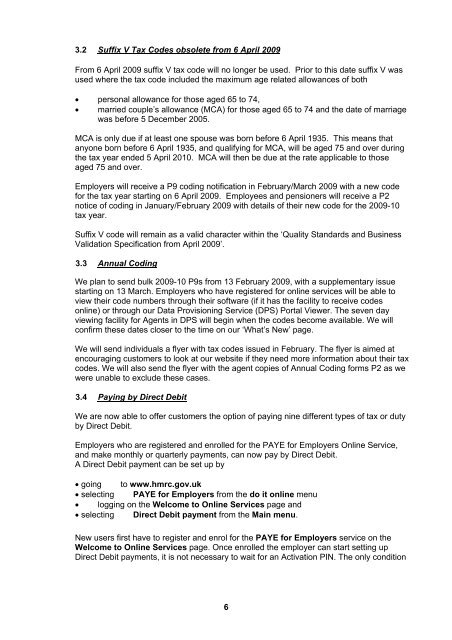HMRC Notes For Payroll Software Developers - HM Revenue ...
HMRC Notes For Payroll Software Developers - HM Revenue ...
HMRC Notes For Payroll Software Developers - HM Revenue ...
You also want an ePaper? Increase the reach of your titles
YUMPU automatically turns print PDFs into web optimized ePapers that Google loves.
3.2 Suffix V Tax Codes obsolete from 6 April 2009<br />
From 6 April 2009 suffix V tax code will no longer be used. Prior to this date suffix V was<br />
used where the tax code included the maximum age related allowances of both<br />
• personal allowance for those aged 65 to 74,<br />
• married couple’s allowance (MCA) for those aged 65 to 74 and the date of marriage<br />
was before 5 December 2005.<br />
MCA is only due if at least one spouse was born before 6 April 1935. This means that<br />
anyone born before 6 April 1935, and qualifying for MCA, will be aged 75 and over during<br />
the tax year ended 5 April 2010. MCA will then be due at the rate applicable to those<br />
aged 75 and over.<br />
Employers will receive a P9 coding notification in February/March 2009 with a new code<br />
for the tax year starting on 6 April 2009. Employees and pensioners will receive a P2<br />
notice of coding in January/February 2009 with details of their new code for the 2009-10<br />
tax year.<br />
Suffix V code will remain as a valid character within the ‘Quality Standards and Business<br />
Validation Specification from April 2009’.<br />
3.3 Annual Coding<br />
We plan to send bulk 2009-10 P9s from 13 February 2009, with a supplementary issue<br />
starting on 13 March. Employers who have registered for online services will be able to<br />
view their code numbers through their software (if it has the facility to receive codes<br />
online) or through our Data Provisioning Service (DPS) Portal Viewer. The seven day<br />
viewing facility for Agents in DPS will begin when the codes become available. We will<br />
confirm these dates closer to the time on our ‘What’s New’ page.<br />
We will send individuals a flyer with tax codes issued in February. The flyer is aimed at<br />
encouraging customers to look at our website if they need more information about their tax<br />
codes. We will also send the flyer with the agent copies of Annual Coding forms P2 as we<br />
were unable to exclude these cases.<br />
3.4 Paying by Direct Debit<br />
We are now able to offer customers the option of paying nine different types of tax or duty<br />
by Direct Debit.<br />
Employers who are registered and enrolled for the PAYE for Employers Online Service,<br />
and make monthly or quarterly payments, can now pay by Direct Debit.<br />
A Direct Debit payment can be set up by<br />
• going to www.hmrc.gov.uk<br />
• selecting PAYE for Employers from the do it online menu<br />
• logging on the Welcome to Online Services page and<br />
• selecting Direct Debit payment from the Main menu.<br />
New users first have to register and enrol for the PAYE for Employers service on the<br />
Welcome to Online Services page. Once enrolled the employer can start setting up<br />
Direct Debit payments, it is not necessary to wait for an Activation PIN. The only condition<br />
6

















